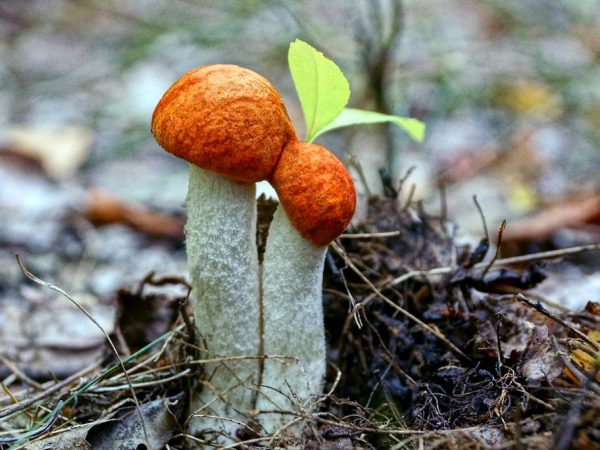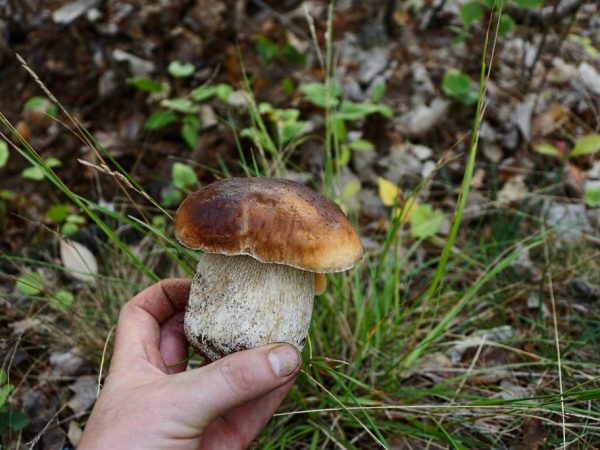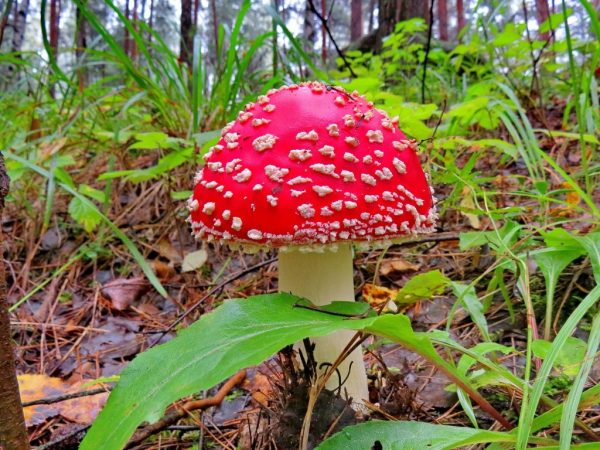Types of autumn mushrooms
Autumn mushrooms contain vegetable protein; they grow in almost all regions of Russia. At this wonderful time of the year, everyone can easily collect a full basket of mushrooms for pickling, pickling, drying or frying.

Types of autumn mushrooms
general characteristics
According to the degree of edibility, the types of autumn mushrooms are divided into the following flavoring categories:
- Category 1: edible (the most delicious and aromatic, among which are white, boletus, milk mushrooms);
- Category 2: conditionally edible;
- Category 3: inedible;
- Category 4: poisonous (fly agaric, pale toadstool).
This classification depends on the percentage of toxins. The more of them, the less edible the selected specimen.
To get rid of the bitterness of conditionally edible mushrooms, you need to soak them for several hours, rinse them in running water several times and only then cook. This process takes a lot of time and requires patience.
Edible mushrooms
The best mushroom season is autumn. Evening and morning coolness, humidity have a good effect on the growth of myceliums. Autumn, according to the collection period, is divided into early and late. Each of these periods has its own characteristics and variety of species.
Early autumn views
The beginning of September is a great time to collect autumn delicacies. Some of the species are still bearing fruit since summer, some are just emerging.
Honey mushrooms
They grow on fallen trunks and stumps, abundantly covered with moss and, accordingly, already decaying. Large groups appear and disappear in waves. Therefore, it is good to look for them in familiar places. Their colonies do not change their place of growth until the age of 13-15. It must be collected carefully, without jerking or damaging the main underground part of the mycelium.
Chanterelles
Chanterelles are translated from Old Russian as "yellow". It is better to look for fox mushrooms in autumn on acidic soils, in deciduous or mixed forests. Their external description is colorful. A cap in the shape of a cone or funnel, bright yellow or orange, stands on a dense tubular stem.
The inner side of the cap is covered with plates of medium thickness. The pulp of the fruiting body is tough, so chanterelles are more often boiled. Sometimes edible chanterelles are confused with conditionally edible ones. They have a similar external description: the same conical cap, color. But there is no waviness around the edges. The false chanterelle has a rounded edge of the cap. Details are important in this case. Chanterelles love moisture, and people collect them immediately after the rains in September.
Champignon
Field and meadow mushrooms are often found in rare withered autumn grass, in glades or in fields. They prefer good lighting and slightly acidic soils.
Irina Selyutina (Biologist):
Champignons meadow and field are widespread in Russia. Fruiting bodies can appear both singly and in groups. You can collect them from June until October-November. At the same time, it is very important to be careful, because these edible mushrooms can be easily confused with pale toadstool and white amanita.Young champignons are distinguished from them by the pink color of the plates (they are white in poisonous mushrooms) and the absence of a well-developed tuberous expansion at the base of the stem. At the same time, the expanded base has on its surface the remains of a blanket - a Volvo.
The mushroom pulp is dense, fleshy, has a pleasant mushroom smell.
Ryzhiki
Another tasty and healthy type of autumn forest mushrooms. The name speaks for itself, red, fiery hats are visible from afar. They can be found in coniferous forests. Young specimens have a convex, slightly rounded cap shape. Then it becomes even, reaching a size of 17-20 cm. This species grows up to 6-8 cm. It is good to salt, pickle or canned mushrooms. The second decade of September is the best time to collect and harvest them.
Russula
In all regions of the current Russian Federation, autumn russula mushrooms grow. Their hats come in different colors - red, gray, lilac, slightly yellow and even spotted. The color depends on the humidity of the climate in which they grow. According to the degree of edibility, they are divided into edible, slightly edible and poisonous. The structure of all species is similar. The pulp is fragile, and the surface of the cap is covered with a thin, slightly sticky film, which can be easily removed if desired.
Porcini

White mushroom can be eaten raw
The most famous and popular mushroom is the king of the forest - the white one. The harvesting season begins in mid-summer and lasts until October. It got its name due to one feature: the pulp does not change its white color even when dried. The demand for them is always high, for several reasons:
- The pulp of these organisms is aromatic, dense and tasty.
- They are easy to clean and cook.
- Even raw, they are edible. Therefore, they are popular among raw foodists.
Their hats are red or brown, large in size, up to 30 cm in diameter. If the weather is humid, the surface becomes sticky. During a drought, cracks appear along the edges of the cap. The leg is thick, keg, barely noticeably reddish and high.
It is better to look for these noble specimens in coniferous, oak or birch groves. Closer to swamps, where there is a lot of peat, they are rare.
Late autumn views
Late autumn is good in its own way. The forest is already empty, the foliage begins to fall, the air becomes clearer and fresher. At this time, late autumn species appear:
- milk mushrooms of all colors;
- winter mushrooms;
- oyster mushrooms;
- greenfinches.
Together with the cold weather, at temperatures below 10 ° C, mushroom flies disappear.
Pine rows appear under the pines and poplars.
Lamellar species of late autumn mushrooms form yellowish fruiting bodies and settle in open meadows. The number of individuals in one group reaches 30-35 pieces. Milk mushrooms have several types. They are black, peppery, blue, white and gray.
Advantages of this species: they are found in different areas, throughout Russia and the absence of poisonous twins. Salted and pickled milk mushrooms have no flavor analogues in the world or in Russia.
Winter mushrooms on one stump can simultaneously grow about 50-60 pieces. The caps of young organisms look like a dome of light beige, slightly slippery on top. They are held on a thin, dense leg.
Irina Selyutina (Biologist):
Winter mushroom belongs to the Ryadovkov family, although the genus Flammulina, of which he actually is a representative, is also referred to the Negniychnikov family. In the center of the cap, the surface has a darker shade. In wet weather, the cap becomes slimy. Adult mushrooms can often become covered with brown spots, which do not affect its taste in any way. Interestingly, cells damaged during severe cold are able to restore their vital activity as soon as the air temperature becomes positive again. As it turned out, this species can be grown in a damp and not very warm basement.
Winter mushrooms settle on deciduous tree species, for example, willows, poplars.In this case, they are parasites, because at the same time, these same trees are a substrate and a food product for them. If winter mushrooms settle on dead plants, then by the way of feeding they pass into the category of saprophytes.
They got the name greenfinch because of their color. This species thrives in most regions of Russia, in mixed, deciduous and coniferous forests.
Outwardly, they look like russula. Fruiting continues until severe frosts and snowfalls. Brown specks are sometimes visible on the cap. The middle is slightly concave inward. With high humidity, a light layer of mucus is noticeable on its surface. The pulp has a pleasant aroma, yellowish tint and dense texture. The leg is cylindrical and low in height.
Oyster mushrooms, like honey mushrooms, grow on old dead trees. For their development, a large amount of cellulose is required. October is the best time for this late look. The pulp always has a certain density. The surface is shiny with a sticky top layer. The aroma is weak. Old fruit bodies are best boiled because of their hardness and dryness.
Inedible mushrooms

Poisonous mushrooms are common in the forest
Pick mushrooms carefully.
Inedible and poisonous varieties include:
- toadstools;
- the rows are greenish;
- the rows are sulfuric;
- Amanita muscaria.
Toadstools are among the most poisonous forest mushrooms. Toxins can penetrate the skin directly into the bloodstream, causing severe bouts of vomiting and diarrhea.
Benefit and harm
The beneficial properties of mushrooms are due to their chemical composition, which includes the following substances:
- magnesium;
- potassium;
- vitamins;
- minerals;
- amino acids.
These elements are essential for the proper functioning of the human body. During the period of infectious diseases, regular consumption of dishes with the addition of mushrooms helps prevent diseases, stimulates the immune system. Some types are used in pharmaceuticals to create medicines: ointments, tinctures, and tablets. Used to treat certain diseases:
- cardiovascular;
- urolithiasis;
- sclerosis;
- cancerous and other tumors;
- gout;
- rheumatism.
Mushrooms for diabetics are an indispensable tool for lowering blood sugar.
But for people suffering from diseases of the gastrointestinal tract, food with mushrooms is contraindicated. Because they, especially in the legs, contain an excess amount of chitin, which causes fermentation in the intestines and prevents digestion.
It is dangerous to collect forest organisms growing near roads, factories, garbage dumps, graves or residential buildings. This is due to the fact that their fruiting bodies are able, like a sponge, to absorb all toxic substances from the environment - air and soil. Collecting "forest meat" in radiation-affected areas leads to radiation sickness.
Conclusion
Autumn is a great time for pleasant and useful walks in the forest. The process of collecting mushrooms will be a real pleasure and will bring many minutes of joy. At the same time, you must not forget about your own safety, take with you a sufficient amount of water, a compass and a knife, put out fires after yourself and not leave behind traces that can disturb, or, as they often say, “spoil” the natural balance in nature.



